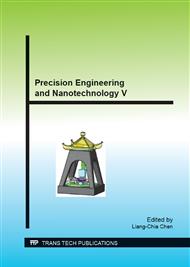p.674
p.678
p.683
p.689
p.695
p.700
p.706
p.712
p.717
Experimental Investigation of Cell Cloning Efficiency after Optical Trapping
Abstract:
In this paper, chemically etched axicon fiber was investigated for laser trapping of micro-object dispersed in liquid. We fabricated axicon micro lenses on a single-mode bare optical fiber by selective chemical etching technique. The laser beam from fiber axicon microlens was strongly focused and optical forces were sufficient to move a microorganisms and biological cells without physical contact. In our experiments, several different lasers with various wavelengths were used as light sources. From these experimental results, it was found that laser wavelength was very important parameter for cell trapping and laser wavelength should be selected to avoid absorption by cells in order to prevent thermal degradation and damage to the cells.
Info:
Periodical:
Pages:
695-699
Citation:
Online since:
August 2014
Authors:
Keywords:
Price:
Сopyright:
© 2015 Trans Tech Publications Ltd. All Rights Reserved
Share:
Citation:


